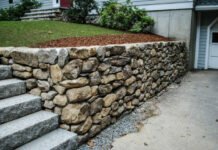When moisture infiltrates the walls, a waterproofing professional can use one of two exterior sealing techniques to prevent further damage. These methods are typically much more involved than interior sealing and require excavation of the basement wall.
Moisture problems are usually caused by improperly graded soil sending water toward the house or clogged drain systems. Addressing these issues is essential to restoring value and function to your home.
Interior Waterproofing
If your basement leaks, a waterproofing company should visit your home to troubleshoot the cause and suggest an appropriate solution. Depending on the root cause, there are different basement waterproofing solutions. Some require less invasive work and keep your budget the same.
Concrete wall cracks can be repaired with epoxy injections or a flexible sealant that fills the gaps, creating a barrier against water and moisture. These solutions are band-aids, however, and need to address the underlying issue. A better option is a vapor barrier that encapsulates the walls and prevents moisture from absorbing into the concrete.
Alternatively, masonry sealants can be applied to the surface of the basement wall. These prevent moisture from seeping through the concrete cover but are less effective in wet soil conditions with high hydrostatic pressure or on masonry foundations with significant cracks.
If you’re considering an interior basement waterproofing solution, installing an internal drainage system is a good idea. These systems comprise pipes and drains running throughout the basement’s interior to catch leaks or groundwater and direct it to an internally located sump pump system. The sump pump then pumps the water out of the basement and away from your home. Drainage problems are one of the most common causes of basement wetness. If gutters aren’t properly installed or clogged, or the ground slopes towards your home, rain and groundwater can collect around your foundation and find their way into your basement.
Exterior Waterproofing
If you find yourself cleaning up puddles in your basement after it rains or if your basement walls are damp and musty, it’s time for a waterproofing solution. Many methods can help, but you must know your root problem and how to correct it.
Interior waterproofing includes a drainage system that reroutes water that leaks down the basement wall away from your home. The drainage system comprises pipes installed on the basement floor to collect groundwater and surface water, which are then directed to a sump pump that is pumped outside. This is a good option if you are uncomfortable installing an exterior drainage system or if your basement has been repaired previously.
Exterior waterproofing involves digging a trench around your home down to the foundation and then sealing the walls with a special membrane or sealant. A drainage system redirects groundwater and surface water away from your home. This method is a little more involved than the inside sealing process but provides a much better solution.
It is also a less expensive solution than the French drain. Exterior waterproofing can be tricky for inexperienced contractors, so choosing a reputable company with a long experience history and great customer reviews is important.
Egress Windows
Egress windows are necessary for any basement finishing project because they provide a safe way out in an emergency and allow natural light into dark spaces. They also spruce up the area below your home, making it more appealing to use as a living space.
However, a window needs to be properly installed and maintained to ensure your basement’s waterproofing is carried. For example, if the window is too small or doesn’t open all the way, it can let water in and introduce moisture that may damage your foundation. To avoid this problem, it’s important to have an experienced contractor install your egress windows.
When installing egress windows, contractors must cut holes into your foundation walls. These holes must be a certain size for the windows to function as an escape route during an emergency. Contractors need to use the proper tools and methods when cutting through these holes to ensure they don’t compromise the structural integrity of your foundation.
In addition, the egress window must be constructed with a lintel that supports and distributes the weight of the basement wall. This will prevent the hole from collapsing and compromising your basement’s waterproofing. Additionally, many contractors will install a vapor barrier on the border and floor of your basement to further protect against moisture.
Drainage
Basements that aren’t properly waterproofed can experience hydrostatic pressure forcing water to push against the foundation walls and through cracks. This can eat away structural elements and create mold, mildew and other health hazards.
If you have cracks in your basement wall, an epoxy coating can seal them and provide a strong barrier against moisture. Waterproofing experts also recommend sealing up any egress windows you have. These are required by code to allow for escape in an emergency.
Waterproofing solutions that use interior drains are a great solution to prevent basement flooding and mold. They can be installed in one to two days. A basement repair expert can help you decide whether an interior drain is right for your home.
Grading your soil can reduce the water that collects around your foundation. This is especially important if your yard has a slope toward the house. Sometimes, a French drain may be recommended for your property to manage the water and steer it away from the foundation.
A window well system may be needed if basement windows are leaking and staining. These galvanized steel or molded plastic pieces can be attached to your home’s exterior foundation and fitted with window well covers to prevent debris from reaching basement windows.


















